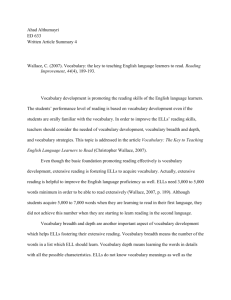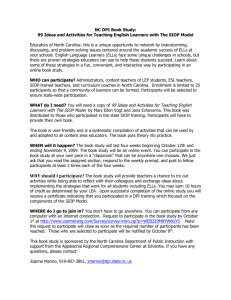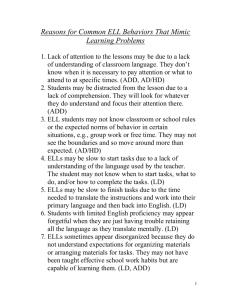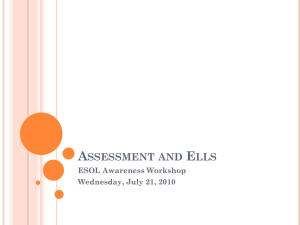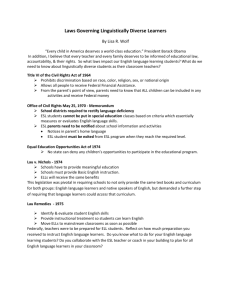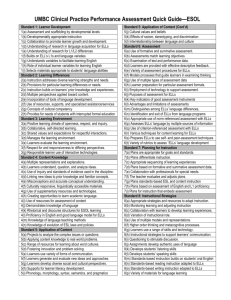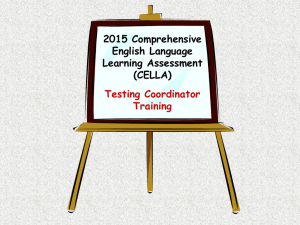Assessment of English Language Learner for Faculty Training
advertisement
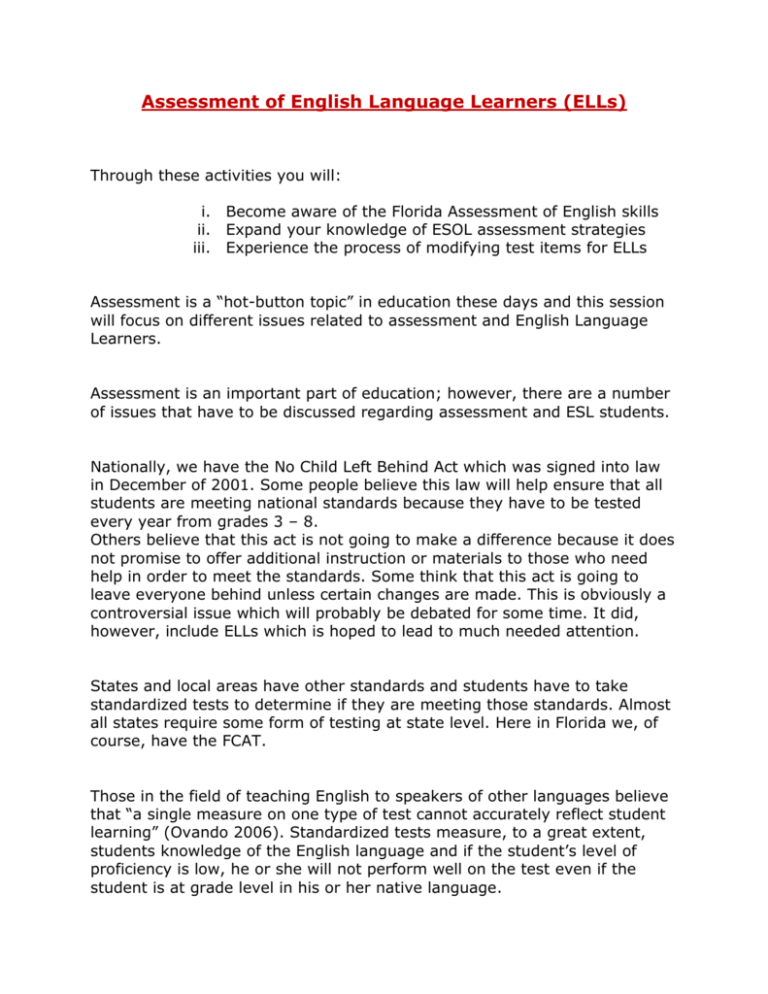
Assessment of English Language Learners (ELLs) Through these activities you will: i. ii. iii. Become aware of the Florida Assessment of English skills Expand your knowledge of ESOL assessment strategies Experience the process of modifying test items for ELLs Assessment is a “hot-button topic” in education these days and this session will focus on different issues related to assessment and English Language Learners. Assessment is an important part of education; however, there are a number of issues that have to be discussed regarding assessment and ESL students. Nationally, we have the No Child Left Behind Act which was signed into law in December of 2001. Some people believe this law will help ensure that all students are meeting national standards because they have to be tested every year from grades 3 – 8. Others believe that this act is not going to make a difference because it does not promise to offer additional instruction or materials to those who need help in order to meet the standards. Some think that this act is going to leave everyone behind unless certain changes are made. This is obviously a controversial issue which will probably be debated for some time. It did, however, include ELLs which is hoped to lead to much needed attention. States and local areas have other standards and students have to take standardized tests to determine if they are meeting those standards. Almost all states require some form of testing at state level. Here in Florida we, of course, have the FCAT. Those in the field of teaching English to speakers of other languages believe that “a single measure on one type of test cannot accurately reflect student learning” (Ovando 2006). Standardized tests measure, to a great extent, students knowledge of the English language and if the student’s level of proficiency is low, he or she will not perform well on the test even if the student is at grade level in his or her native language. Sometimes, students know the subject matter but they do not know enough English so the outcome of the test could indicate that they haven’t mastered the subject matter when in fact it is a language issue. Many language learners spend years before they are ready to take a standardized test. This is due to the length of time it takes a language learner to acquire academic language. ELLs take 5 – 7 years to learn academic language which is often characterized as complex, abstract, and content specific. It is recommended that educators make decisions based on multiple measures and not rely on a single test score. Of course, we all understand that multiple measures provide a more accurate picture of what students know and what they need to work on (strengths and weaknesses). WHAT IS THE PURPOSE OF ASSESSMENT? We use assessment in order to make educational decisions. There are five different purposes for conducting assessment with ESOL students. They are: a) b) c) d) e) Screening and Identification for Placement into the purposes Determining their readiness to exit a program (reclassification) Monitoring their progress in ESOL or regular classroom Accountability for meeting state and other standards Program evaluation to determine the effectiveness of a specific program Teachers need to collect various types of information through the use of different tools before they make decisions regarding students’ leaning or any recommendation for a specific kind of instruction or techniques. It is important to address the issue of bias in assessment and how difficult it is to achieve reliability when assessing English Language Learners. It is important for teachers to become familiar with Cultural bias, Attitudinal bias, Assessment bias, and Test or norming bias. Sometimes it is impossible to avoid some of these issues, but we need to be aware of them and try to reduce their affect on English Language Learners as much as possible. The three most common types of assessments available are: 1. Norm-referenced assessments, 2. Criterion-reference assessments, and 3. Performance-based assessments. The third type (performance-based assessments) is the most desirable with ELLs. Performance-based assessment includes the use of alternative methods such as portfolios, writing samples, oral reports, presentations, projects, etc. This form, I believe, is more reliable because the tools vary and the assessment takes place over a period of time. It is great when assessment is not through the use of multiple-choice questions only when there is often one correct possible answer. Here are some guidelines for testing English Language Learners: Avoid trick questions Use direct speech – indirect speech misleads non-advanced learners Test what you have taught Vary the difficulty level, it is best to go from easy to difficult Provide students with clear directions Explain to the students, in simple language, what is required of them Beware of cultural bias in developing the test and in grading Provide examples and use visuals to clarify directions Give credit for what the student knows Permit more time than is typically allowed for native speakers of English It is always helpful when working with language learners to make a testchecklist to which one can refer before administering a test. ELLs and FCAT: Do students who are English Language Learners (ELLs) take the FCAT? Per the Office of Academic Achievement through Language Acquisition, all English Language Learners (ELLs) are expected to participate in statewide assessments. However, if an ELL has been receiving services in an English for Speakers of Other Languages (ESOL) program operated in accordance with an approved district Limited English Proficient (LEP) plan for one year or less AND a majority of the student’s LEP committee determines that it is appropriate, the ELL may be exempt from the FCAT Writing or Reading administrations. Exempt ELL students must participate in the English proficiency assessment or they will be counted as “not assessed” and will impact the participation rate calculation for Adequate Yearly Progress (AYP). All ELLs are expected to participate in the FCAT Mathematics and Science tests no matter how long these students have been receiving services. Not participating in the FCAT Mathematics assessment will impact the participation rate calculation for AYP. ELLs may take the FCAT using accommodations appropriate for the particular need of the student. It is the responsibility of local school educators to work with students and parents to identify the allowable testing accommodations. Source: http://www.fldoe.org/faq/default.asp?Dept=179&ID=998#Q998 The Comprehensive English Language Learning Assessment Here in the state of Florida, schools use CELLA (The Comprehensive English Language Learning Assessment) as an Assessment tool. It assesses English language skills in the four domains (Listening, Speaking, Reading, and Writing). It is actually meant to measure the students’ mastery of the language skills needed to succeed in school. Research CELLA (one of the assessment tools used in Florida). CELLA is used in Escambia and Santa Rosa Counties. Write a 1 – 2 page paper on your findings (could be longer). This paper should serve as an educational document for new teachers in Florida who need to know about this form of assessment used with ELLs. CELLA information can be found at http://www.fldoe.org/aala/cella.asp Questions can be modified for ELLs depending on their level of proficiency, how long they have been in this country, the teacher’s familiarity with the students’ prior performances, etc. Examples of questions and possible modification/accommodations: (The modifications are written in dark red) Why is a dog classified as a vertebrate instead of an invertebrate? (Hint: EXAMPLES of an invertebrate are insects and mollusks.) a. A dog has a backbone b. A dog has no backbone c. A dog gives birth to live young d. A dog has fur Source of original question: http://www.charliefrench.com/images/LEAP4/sci11.jpg Which of the following organs is not used during digestion? a. Pancreas b. Stomach c. Lungs d. Liver A teacher can certainly accompany this question with a labeled picture of the human body. This could be helpful because, although it seems short and easy, this question has a couple of words with which a beginner or intermediate language learner could struggle. Source of original question: http://www.softschools.com/manage/themes/knowledgetest The school cafeteria is selling green Kool Aid on St. Patrick’s Day. A large cup of Kool Aid is $1.16 and a small cup of Kool Aid is $0.88 On March 17th, students purchased 213 large cups of Kool Aid and 231 small cups of Kool Aid. How much money did the cafeteria collect for – small cups? Large cups? And total? Many forget that math questions often include language or cultural references that are new to ELLs. The above question can be reworded without the inclusion of a particular type of drink or day that maybe unfamiliar to the students. Source of original question: http://www.kidzone.ws/math/wp/t_math.asp?stpatwp5.asp Additional on-line readings: ASSESSMENT WEBSITES: Assessment and Accountability of English for Speakers of Other Languages (June 2000) http://www.tesol.org/s_tesol/sec_document.asp?CID=32&DID=369 Assessing Language-Minority Students http://www.ericdigests.org/1993/students.htm Assessing LEP Migrant Students for Special Education Services http://www.ericdigests.org/1999-3/lep.htm Assessment for the diverse classroom: A handbook for teachers. http://myfloridaeducation.com/commhome/pdf/assess_diverse.pdf Assessment of culturally and linguistically diverse students for special education eligibility. http://hoagiesgifted.org/eric/e604.html Florida Comprehensive Assessment Test. http://www.firn.edu/doe/sas/fcat/fcatsmpl.htm Identifying and Assessing Gifted and Talented Bilingual Hispanic Students http://www.ericdigests.org/1999-2/gifted.htm Portfolio Assessment ESL http://trackstar.4teachers.org/trackstar/ts/viewTrack.do?number=209 619 Practical Ideas on Alternative Assessment for ESL Students http://www.cal.org/resources/digest/tannen01.html Standards-Based Assessment for ESOL Students http://www.cal.org/resources/archive/news/199903/main.html This website http://www.myfloridaeducation.com/omsle/eg6.htm is a helpful resource by the Office of Multicultural Student Language Education. Good book: Scenarios for ESL Standards-Based Assessment – Published by Teachers of English to Speakers of Other Languages, Inc. (2001). Assignment: Step 1: Review the FLDOE website for CELLA. Write a general response relating your personal perspective of the appropriateness of this assessment. Step 2: Read the material that addresses strategies for assessment Step 3: Select a quiz or test from one of your classes. Using information from this module, modify the quiz or test for a second language learner that might be in your actual class. (This may very well be a useful activity to share with your class the next time you teach it.) This would not only model the technical aspects of the modification but also the appropriate disposition.)

